Ionotropic glutamate receptors & CNS disorders
- PMID: 18537642
- PMCID: PMC2662616
- DOI: 10.2174/187152708784083821
Ionotropic glutamate receptors & CNS disorders
Abstract
Disorders of the central nervous system (CNS) are complex disease states that represent a major challenge for modern medicine. Although aetilogy is often unknown, it is established that multiple factors such as defects in genetics and/or epigenetics, the environment as well as imbalance in neurotransmitter receptor systems are all at play in determining an individual's susceptibility to disease. Gene therapy is currently not available and therefore, most conditions are treated with pharmacological agents that modify neurotransmitter receptor signaling. Here, I provide a review of ionotropic glutamate receptors (iGluRs) and the roles they fulfill in numerous CNS disorders. Specifically, I argue that our understanding of iGluRs has reached a critical turning point to permit, for the first time, a comprehensive re-evaluation of their role in the cause of disease. I illustrate this by highlighting how defects in AMPA receptor (AMPAR) trafficking are important to fragile X mental retardation and ectopic expression of kainate receptor (KAR) synapses contributes to the pathology of temporal lobe epilepsy. Finally, I discuss how parallel advances in studies of other neurotransmitter systems may allow pharmacologists to work towards a cure for many CNS disorders rather than developing drugs to treat their symptoms.
Figures






References
Publication types
MeSH terms
Substances
Grants and funding
LinkOut - more resources
Full Text Sources
Other Literature Sources
